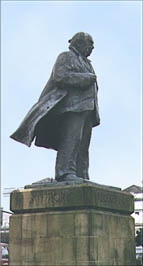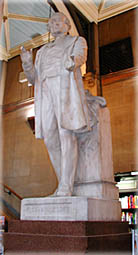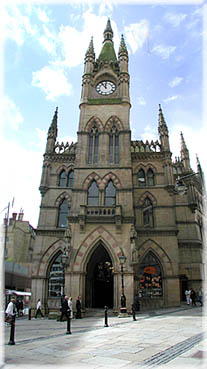AUGUST 2000
|
The Wool Exchange |
Waterstone’s is my favourite bookshop. It is having a difficult time at present faced with competition from, on the one hand, Borders and, on the other amazon.com. I go to one of the Leeds branches of Waterstone’s most weeks; however until I read an article by Stephen McClarence in the Times last month I wasn’t even aware that there was a Waterstone’s in Bradford. It must be twenty-five years since I went in to the centre of Bradford on a working day. The article quoted Douglas Hurd, former Foreign Secretary, describing it as his favourite bookshop whilst Michael Palin, perhaps a little over the top, has said it makes St Mark’s Cathedral in Venice ‘look like Grimsby bus station’. The reason for this is that Waterstone’s Bradford is in the former Wool Exchange, the one-time centre of the Bradford textile industry. Together with four twelve year olds, who had half an hour earlier finished school for the summer holidays and who were therefore in an advanced state of ecstatic euphoria, I went to look. It is indeed wonderful. |
The Wool Exchange was built in the 1860s in Victorian Gothic with pink polished marble columns and a high vaulted timber ceiling. Waterstone’s have restored it most sympathetically and its original features have all been retained including a large statue of Richard Cobden, the Victorian MP and free trader. Until this work was done, since closing as a wool exchange the building had been used as a flea market and allowed to decay. It is a marvellous renaissance. One can sit in the café or the deep leather sofas and admire both the original building and its renewal. Thank you, Waterstone’s.
The
Times article also makes reference to another Bradford statue, in front of the
National Museum of Film and Television. ‘Most imposing, though, is Ian
Judd’s statue of J B Priestley, feet placed firmly on the Pennine earth.
With his overcoat billowing in the wind behind him and his pipe clamped in his
hand, he gazes cannily over a city blighted by dual carriageways and dank
pedestrian subways. There are no statues to town planners’.
|
Normally
one reads with horror how much is spent by Leeds Council and indeed how it is
spent. So it is encouraging to find examples of money being used to maintain
our architectural inheritance for future generations and to improve our city
environment. More than £2 million has been spent in restoring and
refurbishing Leeds City Library, which was designed by George Corson and
opened next to the Town Hall in 1884. The library was closed for a year until
recently during this work which revealed a barrel-vaulted ceiling, carved
arches, elaborate window frames and a decorative fireplace to complement the
existing spacious rooms, stained glass, marble columns and terracotta
embellishment. Behind
the Library, at a cost of £12 million (how do they spend so much?), the new
Millennium Square will open later this year. The surface of the Square will be
limestone and Yorkshire stone. (A welcome change from the cheap and nasty
composite coloured slabs being used elsewhere). There will be gardens, a
fountain and trees planted along Portland Crescent. The plan is that this will
be the city’s most impressive civic space surrounded by the Town Hall, the
Civic Hall, the Civic Theatre and Leeds General Infirmary. There will be
shops, cafes, bars and street theatre. It sounds good. We shall see. Never
trust the Council to do anything properly.
|
Inside The Wool Exchange |
There
is also positive news about Lister’s Mill in Bradford (see June’s diary).
A property company has acquired the South Mill and it is hoped that the money
can be found (£4 million) to restore the roof and make it fit for conversion
into apartments. In the North wing some demolition is planned in order to make
the remainder suitable for business use but this will not affect the outer façade
of the building. So this is at an early stage but it seems that there are
plans for mixed use of Lister’s, which would save it in the same way that
Dean Clough in Halifax and Salt’s Mill in Saltaire were saved. Again, we
shall see.

 Cobden
Cobden
We have just returned from two weeks in Polzeath in Cornwall. This, on the north coast, across the Camel estuary from Padstow, is our favourite part of Cornwall and we keep returning. The Atlantic breaks onto sandy beaches between rocky headlands and it is a centre for surfing. Between Polzeath and Rock is Daymer Bay, behind which is a golf course in the middle of which is St Enodoc’s Church where John Betjeman is buried. This was the part of Cornwall he loved and which he visited all his life. (See Summoned By Bells and Collected Poems passim). Fortunately we were blessed with glorious sunny weather and the boys were able to surf all day. The sun set each evening behind Pentire Point in a mass of different reds, pinks, purples, mauves, indigos and greys. John Betjeman would have loved it.
DB


